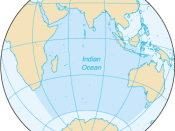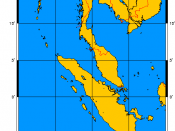The Indian Ocean touches the continents Asia, Africa, Australia and Antarctica. It is the third largest ocean in the world, covering about 20% of water on the earth's surface. Did you know a plane is said to have gone missing over the Indian Ocean? What about the submerged continent located in the ocean or its limited marine life? The Indian Ocean has a rich history and some interesting cases. The Indian Ocean also impacts and affects the way people live on a regular basis.
The Indian Ocean's name derives from the country India. The ocean's shape can be described as the capital letter 'M'. It's silhouette extends from the East Africa coast to the north of the Arabian Sea, down the western coast of India to Sri Lanka, and up India's eastern coast. The eastern arm of the 'M' is formed by the Island of Java, and the west coast of Australia.
The larger region of the Indian Ocean includes three bodies of water in the west: the Arabian (Persian) Gulf, the Red Sea, and the Mediterranean. The east region includes thousands of islands between Southeast Asia and Australia.
The drowned remnants of ancient microcontinents may lie scattered beneath the waters of the Indian Ocean. Although, only one has been confirmed as a microcontinent, they are still looking into the other one. The ancient continent, Mauritia, was thought to be just a legend, until researchers suggested it was torn apart and was slowly buried by the water. To elaborate, 750 million years ago, our planet's land masses were all joined in a supercontinent called Rodinia. Rodinia eventually broke up, and millions of years of volcanic eruptions and plate tectonics eventually split thousands of miles between India and Madagascar, leaving Mauritia surrounded by the Indian Ocean...


